 |
Fortaleza de São Miguel
Luanda, Angola
|
|
 |
Constructed: 1575
Used by: Portugal, Netherlands, Angola
Conflict in which it participated:
Dutch-Portuguese War
Also known as: Fortaleza de São Paulo, Fort Aardenburg
|
Do not be deceived: There absolutely were people in what is today Angola before the Portuguese got there in 1484, in the person of explorer Diogo Cão and his merry band of sailors...but they weren't European people, and European people were the people who made starforts, so for our purposes Angola leapt from nothingness into existence in 1484.
Portuguese nobleman Paulo Dias de Novais (1510-1589) founded the city of São Paulo da Assunção de Loanda on February 11, 1575, making an instant colony with 100 families and 400 soldiers. |
 |
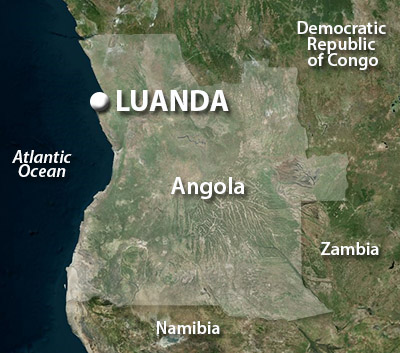 |
|
What is job one for a colonial Governor in a new land in need of strenuous governing? Building a starfort, of course. Initially named after Saint Paul, who taught the gospel of Christ in the 1st century, the first iteration of Fortaleza de São Paulo (which would later be renamed Fortaleza de São Miguel, so pay attention) was made of rammed earth and adobe (a mixture of sand, clay, water and "organic material").
The Portuguese settlement at Luanda was based on an island just off the coast of the modern city: The Fortaleza de São Paulo was sited to guard the bridge that led to that island.
|
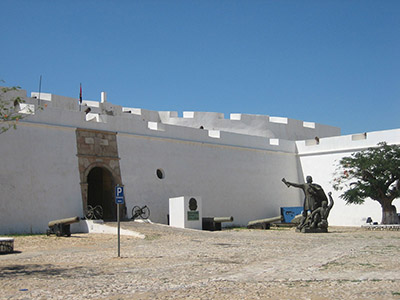 Fortaleza São Miguel's main gate. Fortaleza São Miguel's main gate. |
 |
The Portuguese were initially drawn to the Luanda area in search of precious metals, thanks to knowledge of silver mines at the nearby settlement of Cambambe. Slavery, however, proved to be a much more lucrative and sustainable business model, and Luanda would serve as the main terminal from which Portugal exported slaves to Brazil until 1838. In support of the slave trade, Angola actually operated as a de facto colony of Brazil, itself a Portuguese colony.
While slavery is generally considered to be bad today, it was just business as usual for the Portuguese Empire in the 16th through 19th centuries...and Portugal's main business rival in this part of the world were the Dutch. |
|
|
Another nation that didn't get along with the Dutch was Spain, with whom Portugal entered a "Dynastic Union" in 1580 (the Iberian Union). While the term Dynastic Union might sound like a pleasant undertaking, for the Portuguese it was most definitely not. This state of affairs came about because Portugal's king, Sebastião I (1554-1578), died in 1578 at the Battle of Alcácer Quibirthus in Morocco, and was followed (in death) just over a year later by his successor, Henrique (1512-1580). This left zero breathing heirs to the throne available to legitimately ascend to that throne, making Spain's King Philip II (1527-1598) somehow able to claim Portugal's throne as well as his own.
As part of this union Portugal remained somewhat independent, but did not have any control over its foreign policy, which in 1580 included the governance of a lot of widely-spread colonies, trading posts and, most importantly, starforts.
Another "benefit" of union with Spain was Portugal's forced participation in the ongoing Eighty Years' War (1568-1648) betwixt Spain and the Netherlands, which sprung from the eminently reasonable desire of the latter to be free from the clutches of the former. Shooting off from this larger war like a tender young branch was the Dutch-Portuguese War (1602-1663), which mostly took the form of the Dutch Navy taking advantage of Portugal's "Dynastic Union" discomfiture by swooping in and snapping up its underdefended colonies.
|
Spain's King Philip III (1578-1621) would have hated to lose his (*cough* of course he meant Portugal's) colony at Luanda to the Dutch, so he ordered the further fortification of Luanda Bay. Three more starforts would be built to defend Luanda: Fortaleza São Pedro da Barra in 1618; Fortaleza de Nossa Senhora da Flor da Rosa in the mid-1600's; and Forte de São Francisco do Penedo in 1765. These forts were arrayed both up the coast from Fortaleza de São Paulo and on the island of Luanda, and for a time could create a murderous crossfire against any who might try to enter the bay.
Not that it mattered: The Dutch swept in and captured both Luanda and all its forts in 1640.
|
 |
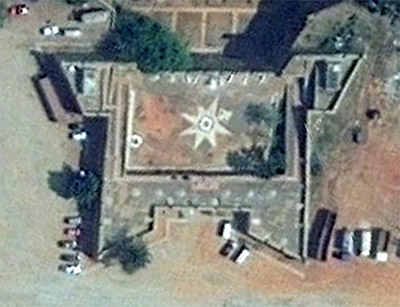 The tiny Fortaleza São Pedro da Barra, with a compass helpfully pointing north within, lest anyone be directionally confused. The tiny Fortaleza São Pedro da Barra, with a compass helpfully pointing north within, lest anyone be directionally confused. |
|
The year in which Luanda was captured by the Dutch is interesting, in that it also happens to be the same year in which Portugal finally extricated itself from the ridiculous Iberian Union. One imagines that the Dutch had by this time become masters at sensing Portuguese weakness and/or confusion, and knew that Portugal would need time to re-establish itself in its disparate colonies before it could defend them.
|
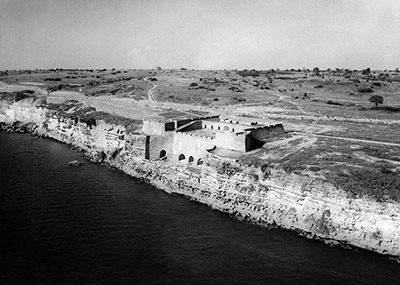 Fortaleza São Pedro da Barra, back when the world was black & white. While in command of Luanda, the Dutch put a lot of effort into this fort: A water battery was dug out of the rock cliffs before the fort, along with a powder magazine and guardroom. Fortaleza São Pedro da Barra, back when the world was black & white. While in command of Luanda, the Dutch put a lot of effort into this fort: A water battery was dug out of the rock cliffs before the fort, along with a powder magazine and guardroom. |
 |
From 1640 to 1648, the starfort of our current interest was known as Fort Aardenburg. A city at the southwest extremity of the Netherlands, Aardenburg had its own impressive history of fortification, and from whence, it is assumed, some of the Dutchmen who captured Luanda came.
A Portuguese attempt to retake Luanda from the Dutch came in August of 1648: 900 men led by Salvador Correia de Sá (1602-1688), a military man who traveled the globe doing various important and heroic things in Portugal's far-flung colonies.
Sá and his column attacked the Fortaleza de São Paulo on August 15, 1648. |
|
|
The fort was manned by 1200 Dutch soldiers "and many blacks," and after the first Portuguese attack was repulsed with heavy losses, Sá was thinking that the Fortaleza was secure from his reconquista desires...when, on August 16, the Dutch inexplicably surrendered, and sailed placidly away. Upon hearing of the fall of Luanda, Dutch forces also abandoned several other towns in Angola that they had occupied in 1641. Sá was Portuguese Angola's savior, and served as Governor of that colony until 1651. And, most importantly, the export of slaves to Brazil recommenced. Thank goodness.
Salvador Sá is also responsible for giving our Fortaleza it's proper name, shortly after restoring it to the Portuguese fold: Archangel Michael, among other interpretations, led the army of God against the forces of evil in the Bible...and was of particular affinity to Salvador Sá. Forever after, it was known as Fortaleza de São Miguel. Amen.
|
While Governor, Salvador Sá ordered the further development of Luanda's fortifications, and brought in French military engineer Pierre Pelique to do the honors. Improvements followed improvements, and by the mid-1670's the fort had finally taken on the appearance we see today, with two landward-facing bastions.
One of the improvements was the addition of a ravelin, evidence of which can be seen at the far right in the picture at the top of this page. A triangular bastion, standing free from the main body of the fort and usually armed to act as a minifort, a ravelin was located before a fort's main gate, intended to prevent an enemy from firing cannon directly into that gate. All ravelins, however, were not created equal.
Fortaleza de São Miguel's ravelin was tiny, leaving an enemy some angles of opportunity for firing upon the gate...plus it was too small to arm properly, with only room for a couple of small guns atop. As you can see, the ravelin has not survived to the present day, but was declared worthless and dismantled sometime after 1861. |
 |
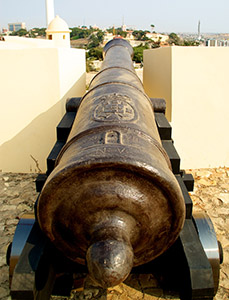 A Portuguese gun, now in its fourth century of defending Luanda from the wicked Dutch. |
|
|
Brazil gained full independence from Portugal in 1822. News of one colony's departure from the fold is ever disruptive in other colonies, and trouble started in the Fortaleza de São Miguel that same year. A mutiny of the fort's garrison, which one assumes were mostly native troops (the aforementioned "many blacks") occurred in 1822, and festering unease lasted into the 1830's, culminating in the murder of the Fortaleza's commander by his own troops on August 30, 1836.
|
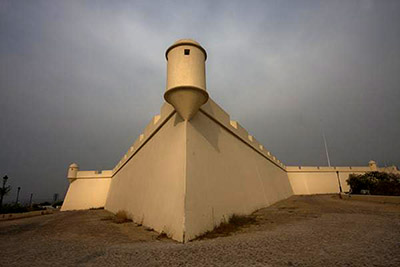 Dark sky, bright starfort. Dark sky, bright starfort. |
 |
Whatever measures were taken to dampen the natives' enthusiasm for revolt must have worked, because Fortaleza de São Miguel existed as a Portuguese colonial prison for the next hundred years.
Much of what made the Fortaleza a proper defensive edifice was destroyed in 1882, when the colonial government determined that the fort's future was that of an unpleasant prison, as it would never ever be called upon to serve the role as a fort. While retaining its outward pointy appearance, the interior of the Fortaleza now consisted of jail cells and little else.
|
|
|
Angola's modern borders, indeed the borders of most of Africa's current nations, were set by the Berlin Conference if 1884-1885. Germany had become a unified nation in 1871, and was in the process of attempting to elbow out every other European power in the mad dash to colonize Africa: The Berlin Conference formalized this mad dash, which led to further mad dashing. By 1913, all of Africa (except for Liberia and modern Ethiopia) was formally claimed by Belgium, Germany, Spain, France, Great Britain, Italy and/or Portugal.
The last of the convicts incarcerated in the Fortaleza were removed on September 8, 1938. The fort was immediately rechristened the Museum of Angola, no doubt initially displaying convincing depictions of blood-stained walls and torture devices...at least until the place was thoroughly cleaned.
|
While most of those European powers semi-graciously left their African colonies to their own devices after the Second World War (1939-1945), Portugal did not: They had been the first colonial entity to plant a flag in Africa at Ceuta (home of the now-Spanish Fortaleza de Hacho) in 1415, and they would prove to be the last to leave Africa. The Fortaleza de São Miguel was occupied by a Portuguese Paratroop Battalion in 1961, shortly after open conflict broke out. Angola finally clawed its way to independence from Portugal in 1975: The Portuguese flag was lowered over the Fortaleza on November 10 of that year, and Angolan independence was officially proclaimed the following day. The Angolan Civil War immediately thereafter burst into being. This conflict stretched from 1975 to 2002, leaving half a million Angolans dead. |
 |
 The North American T-6 Texan is an American trainer aircraft, initially built to train US Army Air Corps and RAF pilots during the Second World War (1939-1945). This aircraft was sold to any number of semi-friendly nations in need of a boost to their air forces in the following three decades, armed, and often used as a ground-attack platform. Portugal bought over a hundred of these planes from the US and utilized them in the period in which they were desperately clinging to their African colonies in the 1960's. These specimens, still decorated in their Portuguese finery, sit outside the Fortaleza's walls today. |
|
|
The Fortaleza de São Miguel served various parties through the conflict as headquarters and administrative housing (and surely was also used to incarcerate disagreeable folks). Finally in 1995 the fort underwent a series of "conservational interventions," and today houses the Museu das Forças Armadas, or Museum of the Armed Forces.
|
|
|
|
|
|
 |




